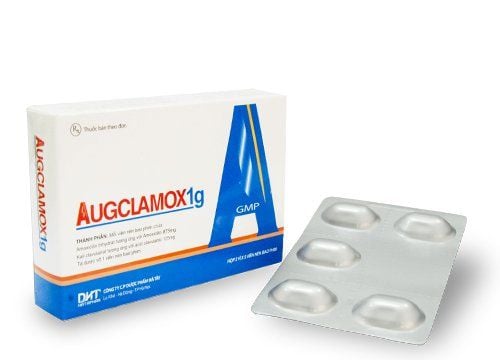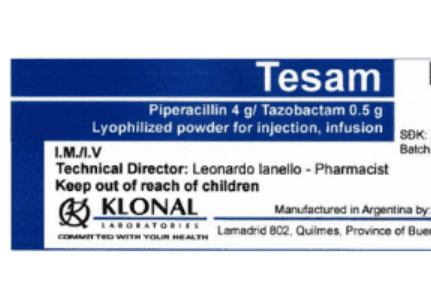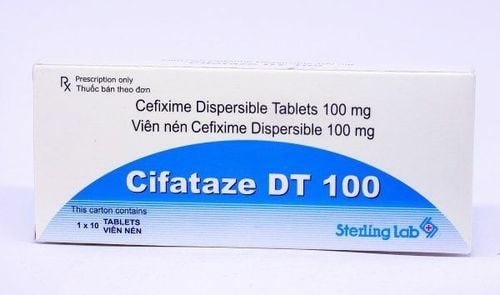This is an automatically translated article.
Cefimed 400 mg is a drug manufactured by Medochemie Company, with the main ingredient being Cefixime trihydrate. This antibiotic is used to treat infections of the upper and lower respiratory tract, urinary tract infections.
1. What is Cefimed 400mg?
Cefimed 400 mg is a cephalosporin antibiotic with the main active ingredient being Cefixime trihydrate. The antibiotic cefixime is commonly used to treat respiratory and lower urinary tract infections. Cefimed 400 mg is produced in the form of film-coated tablets. Each tablet contains Cefixime trihydrate equivalent to 400 mg Cefixime.
Cefixime is a 3rd generation Cephalosporin antibiotic used orally. Cefixime, like other cephalosporins, is an antibacterial agent by inhibiting bacterial cell membrane synthesis by binding to one or more PBPs (penicillin binding proteins).
The antibacterial spectrum of cefixime with each type of bacteria will be different, because it is related to the binding affinity of cefixime to PBPs. When the drug binds to PBP, cefixime destabilizes the bacterial cell wall, thereby changing the permeability and killing the bacteria. The cephalosporins also have a mechanism to increase the destruction of bacterial cell membranes by reducing the inhibitory effect of the enzyme murein hydrolase. Enzymes have the effect of destroying the integrity of the cell wall when not inhibited.
2. Uses of Cefimed 400mg
2.1.Indications of the drug Cefimed Cefimed antibiotics are indicated for the treatment of acute infections caused by strains of bacteria sensitive to cefixime in organ infections such as:
Upper respiratory tract infections such as sinusitis , tonsillitis , Otitis media , pharyngitis , Lower respiratory tract infections such as acute bronchitis or exacerbations of chronic bronchitis and pneumonia. Genitourinary tract infections such as uncomplicated cervical and urethral gonorrhea, cystitis, urethral or pyelonephritis.
3. Dosage of Cefimed 400mg
Cefimed 400mg is taken orally, use whole tablets with water before or after eating. The duration of a course of treatment is usually 7 days, or it can be extended up to 14 days in severe infections or infections caused by strains of bacteria that are less susceptible to the drug.
Patients should take the medicine at a fixed time each day to get a stable concentration and get the best effect. The recommended dose for most infections is 200 to 400 mg/day, depending on the pathology. Can be used as a single dose or divided into 2 doses per day.
For some special diseases such as gonorrhea, the recommended dose is a single dose of 400 mg or 800 mg/day.
4. What to do when overdose or forget dose of Cefimed 400mg?
Currently, no cases of overdose with cefixime have been reported. Symptoms can be similar to those of side effects. Cefixime has no specific antidote. Treatment of overdose can be gastric lavage and mainly supportive treatment, symptomatic relief.
If you have missed a dose you need to take it as soon as possible. However, if it is almost time for your next missed dose, skip the missed dose and take your next dose as usual. Do not double the dose as prescribed.
5. Side effects of Cefimed 400Mg
Some unwanted effects when using Cefixime include:
Common gastrointestinal symptoms are nausea, vomiting, diarrhea, flatulence, abdominal pain, indigestion. Neurological symptoms such as headache, dizziness Hypersensitivity reactions to the drug: Fever, urticaria, pruritus, rash. These reactions will decrease and completely disappear when the drug is stopped. A rare case may be back pain In addition, there are other rare side effects such as:
Hematologic: Increased eosinophils, thrombocytopenia and white blood cell count, the reactions are reversible. recovery after drug discontinuation. Genitourinary tract such as genital itching, vaginitis, Candida superinfection. Transient elevation of liver enzymes Transient elevation of blood urea and creatinine Very rare cases of pseudomembranous colitis due to cefixime Most adverse effects during use are mild and rarely require discontinuation of the drug. Therefore, you need to immediately inform your doctor about the side effects you experience while taking the drug.
6. Contraindications of Cefimed 400 mg
Cefimed 400 mg is contraindicated in patients with hypersensitivity to cephalosporin antibiotics or to any of the ingredients in the formulation. Cefixime is indicated with caution in patients with a history of penicillin allergy. There is some evidence of cross-allergy between cephalosporins and penicillins. Similarly, caution should be exercised when prescribing cefixime in any patient with a previous allergy to any drug, since an allergy is more likely to occur. Cefixime should be used with caution in patients with severe renal impairment. As with other broad-spectrum antibiotics, use of cefixime may lead to overgrowth of non-susceptible organisms. In this case, appropriate clinical and therapeutic therapy should be applied. Treatment with cefixime may induce changes in the gut microbiota, which may cause overgrowth of Clostridia species. Patients with massive, severe bloody diarrhea are likely to develop pseudomembranous colitis due to Clostridia difficile toxicity. It can happen during or after completing a course of antibiotics. This case of diarrhea should be fully and promptly evaluated, including sigmoidoscopy and culture. Other causes of colitis should be ruled out. Supplemental fluids, electrolytes and proteins are required. If colitis does not improve upon discontinuation or symptoms worsen, oral vancomycin therapy is recommended. Changes in liver function test results have been reported. Liver function should be monitored in patients with hepatic impairment, especially during high doses and prolonged use. Prolongation of prothrombin time with cephalosporins. It has been reported that close monitoring of patients with anticoagulants is warranted. Live typhoid vaccine should not be given to patients being treated with cefixime. It should only be used at least 24 hours after the last dose of cefixime, as the immune response to the vaccine may be reduced. Theoretically, co-administration of aminoglycoside antibiotics with cephalosporins increases nephrotoxicity. These two drugs should not be used together in patients with renal failure. In case of necessity, use in patients without renal failure, it is necessary to monitor the level of toxicity on the kidneys. Due to the decrease in intestinal microflora - the microflora that synthesize vitamin K, patients are likely to have vitamin K deficiency when treated with cefixime. In patients with poor nutrition, alcoholics, or patients with malabsorption syndromes, there is an increased risk of vitamin K deficiency. Cefixime should be administered with caution in patients with a history of colitis, as these patients are at increased risk for the development of pseudomembranous colitis. Pregnancy: Cefixime should not be used during pregnancy, unless clinically necessary and after careful consideration of the potential harm to the fetus relative to the potential benefit to the mother. . Lactation: There are no data to show that Cefixime is excreted in human milk. Therefore, breastfeeding should be discontinued during treatment with Cefixime. Cefimed 400 mg is a drug manufactured by Medochemie Company, with the main ingredient being Cefixime trihydrate. This antibiotic is used to treat infections of the upper and lower respiratory tract, urinary tract infections.
Follow Vinmec International General Hospital website to get more health, nutrition and beauty information to protect the health of yourself and your loved ones in your family.
Please dial HOTLINE for more information or register for an appointment HERE. Download MyVinmec app to make appointments faster and to manage your bookings easily.













